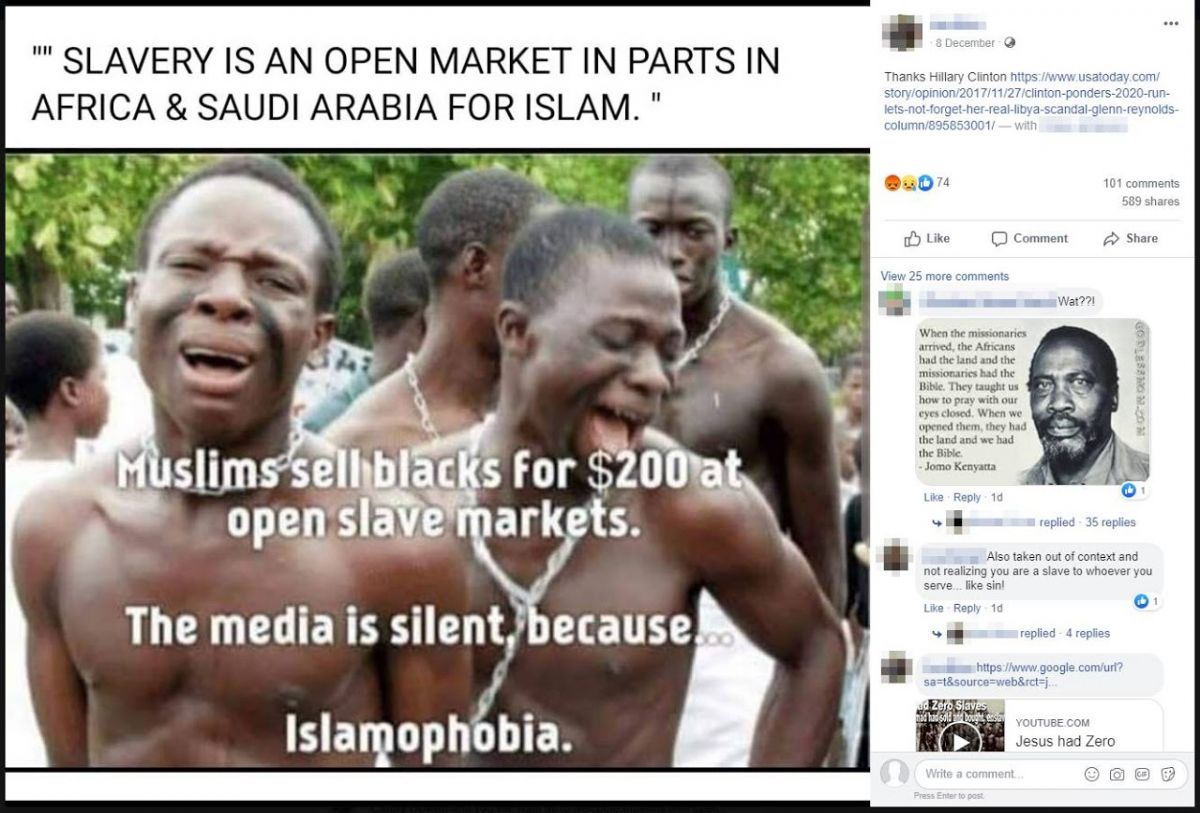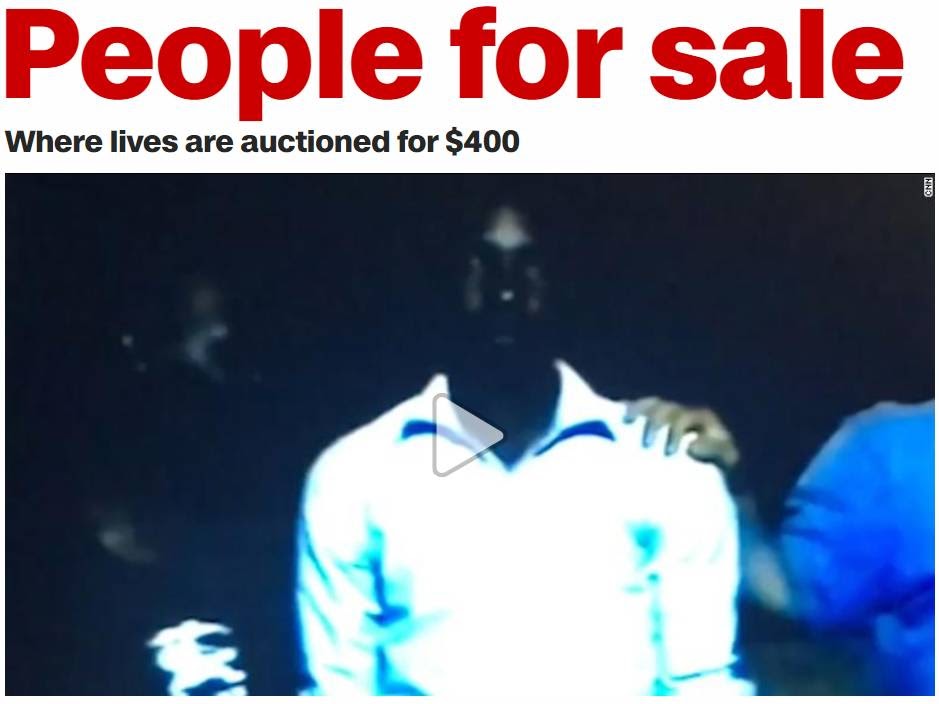The Statement
A Facebook post from an Australian user on December 8 and examined by AAP FactCheck, allegedly shows people being sold off as slaves.
The post features a photo of a four young men of African appearance linked together by chains hung around their necks, with two of the men in apparent distress.
Above the image is text that reads: “SLAVERY IS AN OPEN MARKET IN PARTS IN AFRICA & SAUDI ARABIA FOR ISLAM”.
Overlaid on the image is derogatory text that reads: “Muslims sell blacks for $200 at open slave markets. The media is silent, because … Islamophobia”.
The caption accompanying the post reads: “Thanks Hillary Clinton” and contains a link to a 2017 opinion piece published on USA Today that blames former US Secretary of State Clinton for slave markets exposed by a media investigation in Libya.
The Facebook post has attracted more than 500 shares, 70 reactions and 100 comments.
The same meme appeared on a quarantined Reddit forum, r/The_Donald, in January, 2019.

The Analysis
A reverse image search reveals the photo in the post not to be slaves but performers photographed at a re-enactment of slavery at a heritage festival in 2002. The picture was taken by photographer George Esiri in Nigeria’s port town of Badagry on August 25, 2002.
The photo is in the image library of international news agency Reuters and appears on the Adobe Stock image catalogue marked “editorial use only” and with usage rights priced at up to $263.99.
The photo caption reads: “Local people with chains on their necks re-enact the days of slavery in slave port town of Badagry, south-west Nigeria on August 25, 2002. More than fifty black Americans including seven mayors are in Lagos for the 2nd Black Heritage Festival which commenced with cultural activities.The initiation ceremonies will take place on Monday.”
AAP FactCheck found two articles, published by the Jamaica Gleaner in 2009 and 2013, on the topic of slavery that used the photo while noting it was a re-enactment.

The post’s claim, in quote marks, that “slavery is an open market in parts in (sic) Africa & Saudi Arabia for Islam” has no attribution.
The 2018 Global Slavery Index (GSI) – an independent assessment published by philanthropic foundation Walk Free – states that slavery exists in Africa and Saudi Arabia.
The GSI estimates that 9.2 million men, women, and children were living in modern slavery in Africa in 2016, with the region having the highest prevalence (7.6 people for every 1,000) in the world.
Neighbouring Saudi Arabia had an estimated 61,000 people trapped in modern-day slavery at the time but was lower on the prevalance ranking at 138th of 167.
The report does note, however, that there are gaps in data for the Arab States region and Persian Gulf countries and that the gaps “point to a significant underestimate of the extent of modern slavery in this region”.
The Facebook post’s claim that people are being sold for “$200 at open slave markets” may be based on a 2017 International Organisation for Migration (IOM) report on the experiences of West African migrants in the North African country of Libya.
As recounted in multiple media reports, including from Reuters, Euronews, The Times and Al Jazeera, IOM’s Libya mission head Othman Belbeisi told journalists at a news conference in Geneva in April, 2017 that African migrants had been sold into bondage at Libyan slave markets for “between 200 and 500 dollars”.
Reporters with US news channel CNN uncovered first-hand evidence of the slave trade later that year, secretly filming a clandestine slave auction in Libya where people were sold.
Regarding the post’s claim that the slavery market is “for Islam”, the GIS report shows a mix of religions among African nations that appear in the top 10 for prevalence of slavery.
Eritrea (second) is an equal mix of Christianity and Islam according to the CIA World Factbook, Burundi (third) is majority Christian, Central African Republic (fourth) is a mix of indigenous beliefs and Christianity with a small proportion of Islam, Mauritania (sixth) is a Muslim country and South Sudan (seventh) is majority Christian.
Afghanistan (fifth), Pakistan (eighth) and Iran (10th) – all Muslim faith nations – are also in the top 10 the list while fellow Islamic nation Libya ranked 29th.
Authoritarian state North Korea, which is traditionally Bhuddist, topped the world for the highest prevalence of modern slavery.
The GIS report states that of the 10 countries with the highest prevalence of slavery, the two major drivers are highly repressive regimes and conflict.
Russia and China are listed among the countries with the largest estimated total number – as opposed to per-capita rate – of people in modern slavery.
Finally, the post claims that “the media is silent because … islamophobia” – an apparent implication that the media is not reporting on slavery in Muslim nations out of a fear of being seen to be endorsing anti-Muslim sentiment.
Contradicting this claim is the fact that there are multiple media reports, previously alluded to, on the slavery situation in Libya, and there is reporting more broadly on the slavery situation in Libya and Africa.
The Verdict
Based on the evidence, AAP FactCheck found the image in the post is false as it is not from an “open slave market” but rather a re-enactment of slavery at a 2002 festival.
The text falsely claims that the media has been silent on reports of slave markets in Islamic countries. This claim is proven false by media reporting on the subject, including reports that provide the information used in the post of slaves being sold for $200.
Regarding the post’s claim that the slavery market is “for Islam”, the GIS report shows a mix of religions among African nations that appear in the top 10 for prevalence of slavery and notes that repressive regimes and conflict are the main drivers of the practice.
False – The primary claim of the content is factually inaccurate.
First published December 13, 2019, 17:03 AEDT


















